BMP3003 Further Academic Skills: Academic Integrity Report Analysis
VerifiedAdded on 2022/12/26
|9
|2752
|34
Report
AI Summary
This report, prepared for the Further Academic Skills module (BMP3003), delves into the multifaceted concept of academic integrity within higher education. The first section of the report introduces academic integrity, defining it as the ethical conduct expected of scholars, emphasizing honesty, trust, fairness, respect, and responsibility. It then elucidates the importance of upholding academic integrity for both students and institutions, highlighting its role in fostering new ideas, developing skills, and maintaining the reputation of the university. The report also examines the implications of academic misconduct, including academic and legal consequences, loss of intellectual property, inaccurate assessments, and other practical concerns. The second section provides a reflection on the process of designing a game for a previous assignment, detailing the steps taken, the challenges encountered, and the skills learned and utilized during the game's creation, such as imagination, creativity, design, organization, and written communication. The report concludes by summarizing the key findings and emphasizing the significance of academic integrity in the academic environment.
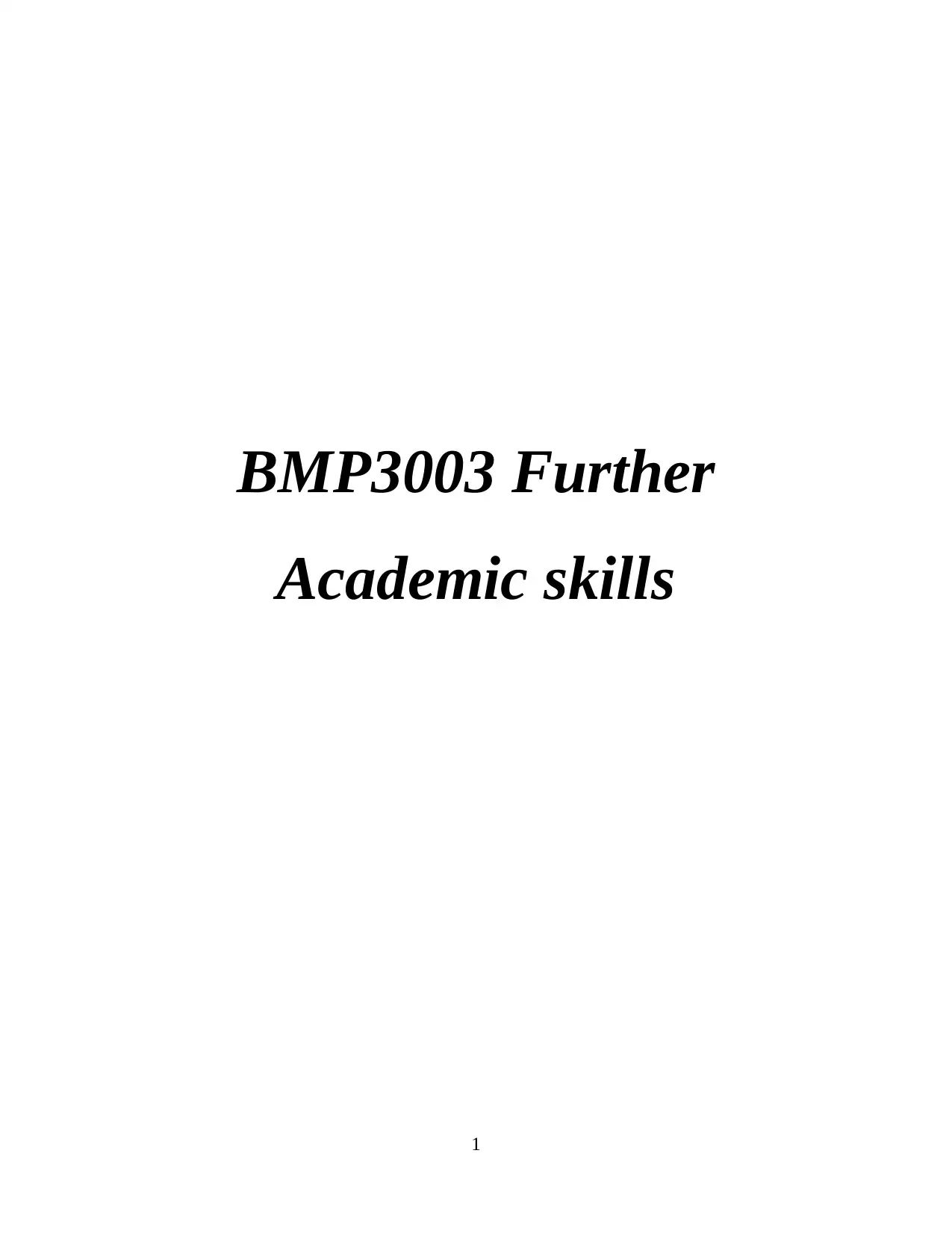
BMP3003 Further
Academic skills
1
Academic skills
1
Paraphrase This Document
Need a fresh take? Get an instant paraphrase of this document with our AI Paraphraser
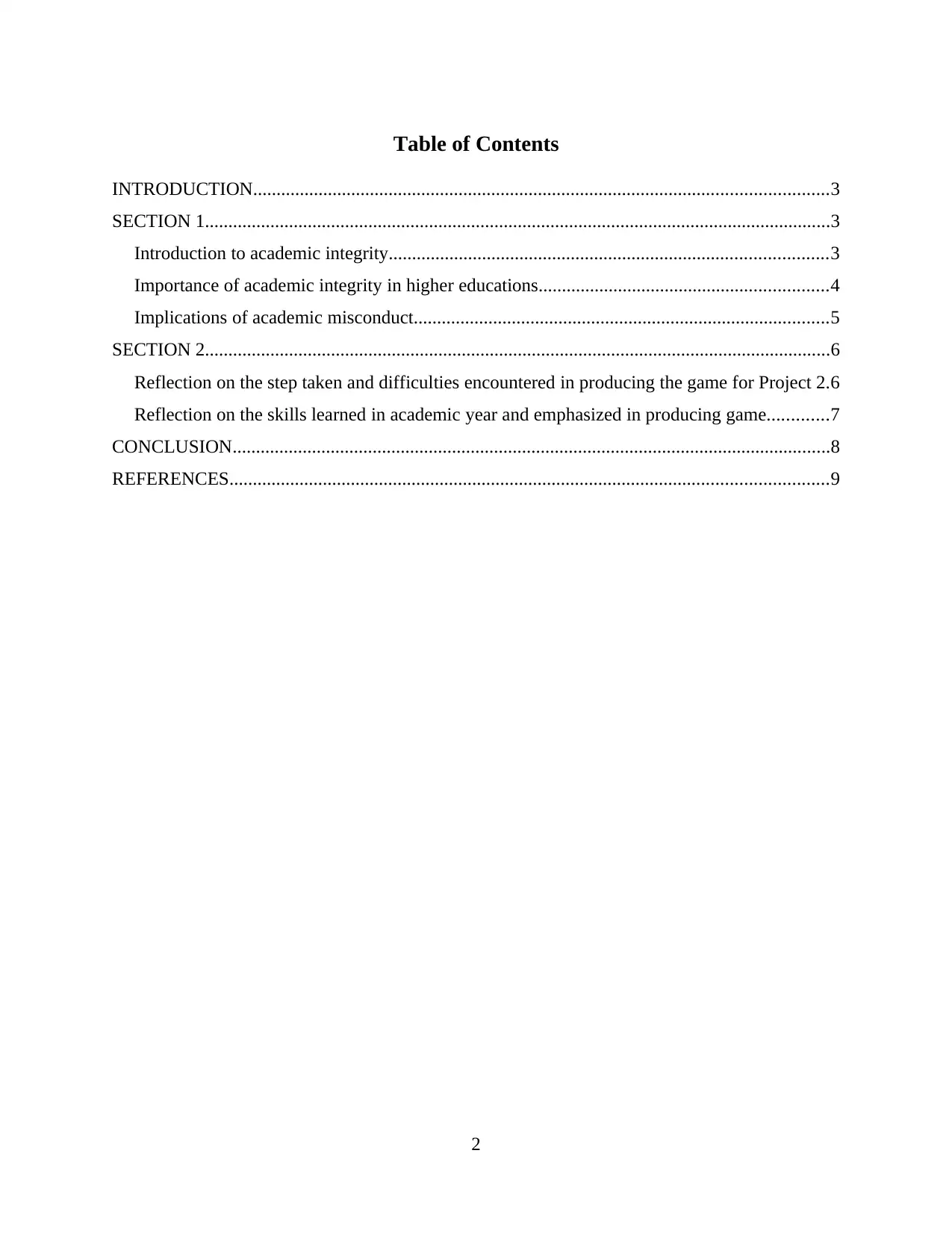
Table of Contents
INTRODUCTION...........................................................................................................................3
SECTION 1......................................................................................................................................3
Introduction to academic integrity..............................................................................................3
Importance of academic integrity in higher educations..............................................................4
Implications of academic misconduct.........................................................................................5
SECTION 2......................................................................................................................................6
Reflection on the step taken and difficulties encountered in producing the game for Project 2.6
Reflection on the skills learned in academic year and emphasized in producing game.............7
CONCLUSION................................................................................................................................8
REFERENCES................................................................................................................................9
2
INTRODUCTION...........................................................................................................................3
SECTION 1......................................................................................................................................3
Introduction to academic integrity..............................................................................................3
Importance of academic integrity in higher educations..............................................................4
Implications of academic misconduct.........................................................................................5
SECTION 2......................................................................................................................................6
Reflection on the step taken and difficulties encountered in producing the game for Project 2.6
Reflection on the skills learned in academic year and emphasized in producing game.............7
CONCLUSION................................................................................................................................8
REFERENCES................................................................................................................................9
2
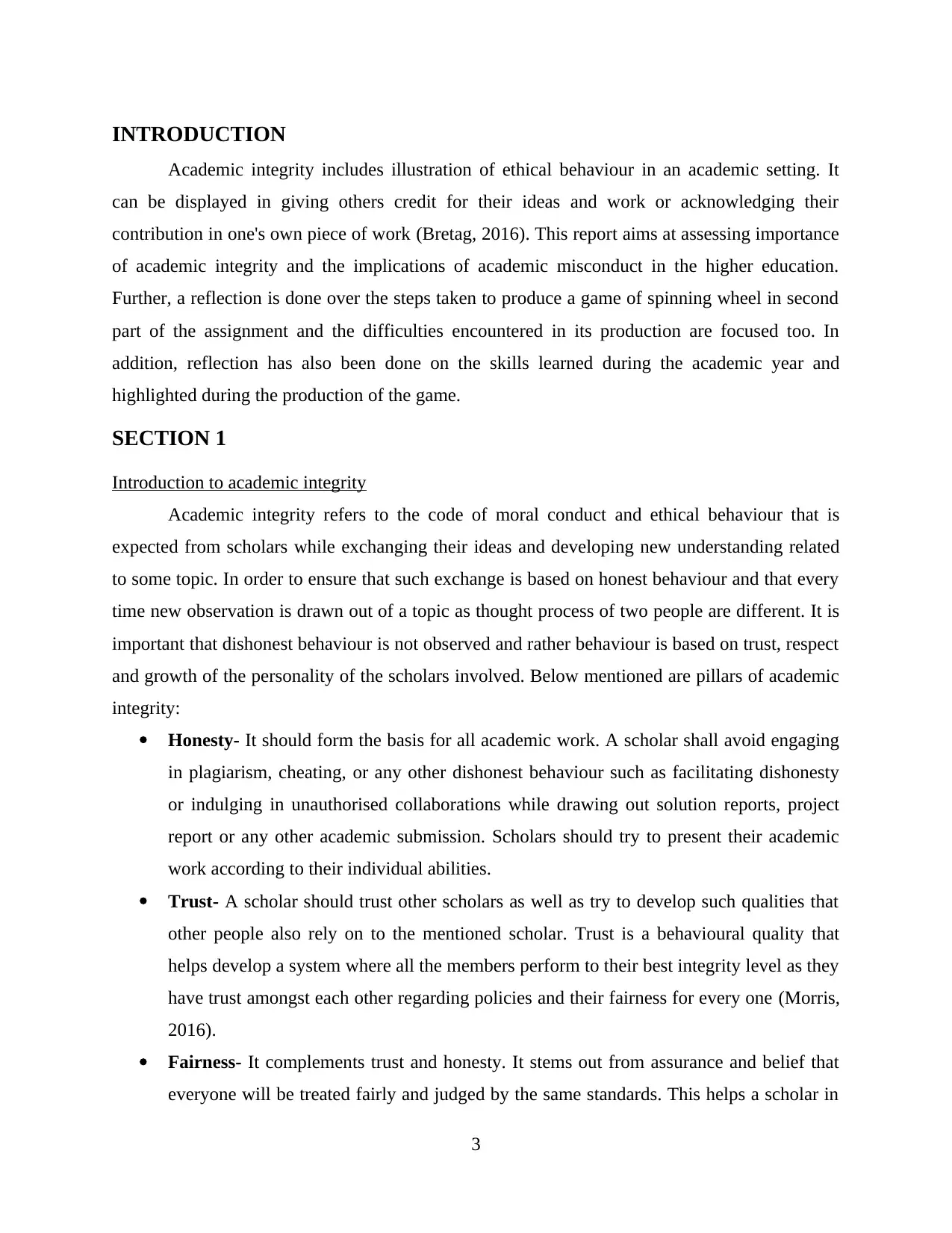
INTRODUCTION
Academic integrity includes illustration of ethical behaviour in an academic setting. It
can be displayed in giving others credit for their ideas and work or acknowledging their
contribution in one's own piece of work (Bretag, 2016). This report aims at assessing importance
of academic integrity and the implications of academic misconduct in the higher education.
Further, a reflection is done over the steps taken to produce a game of spinning wheel in second
part of the assignment and the difficulties encountered in its production are focused too. In
addition, reflection has also been done on the skills learned during the academic year and
highlighted during the production of the game.
SECTION 1
Introduction to academic integrity
Academic integrity refers to the code of moral conduct and ethical behaviour that is
expected from scholars while exchanging their ideas and developing new understanding related
to some topic. In order to ensure that such exchange is based on honest behaviour and that every
time new observation is drawn out of a topic as thought process of two people are different. It is
important that dishonest behaviour is not observed and rather behaviour is based on trust, respect
and growth of the personality of the scholars involved. Below mentioned are pillars of academic
integrity:
Honesty- It should form the basis for all academic work. A scholar shall avoid engaging
in plagiarism, cheating, or any other dishonest behaviour such as facilitating dishonesty
or indulging in unauthorised collaborations while drawing out solution reports, project
report or any other academic submission. Scholars should try to present their academic
work according to their individual abilities.
Trust- A scholar should trust other scholars as well as try to develop such qualities that
other people also rely on to the mentioned scholar. Trust is a behavioural quality that
helps develop a system where all the members perform to their best integrity level as they
have trust amongst each other regarding policies and their fairness for every one (Morris,
2016).
Fairness- It complements trust and honesty. It stems out from assurance and belief that
everyone will be treated fairly and judged by the same standards. This helps a scholar in
3
Academic integrity includes illustration of ethical behaviour in an academic setting. It
can be displayed in giving others credit for their ideas and work or acknowledging their
contribution in one's own piece of work (Bretag, 2016). This report aims at assessing importance
of academic integrity and the implications of academic misconduct in the higher education.
Further, a reflection is done over the steps taken to produce a game of spinning wheel in second
part of the assignment and the difficulties encountered in its production are focused too. In
addition, reflection has also been done on the skills learned during the academic year and
highlighted during the production of the game.
SECTION 1
Introduction to academic integrity
Academic integrity refers to the code of moral conduct and ethical behaviour that is
expected from scholars while exchanging their ideas and developing new understanding related
to some topic. In order to ensure that such exchange is based on honest behaviour and that every
time new observation is drawn out of a topic as thought process of two people are different. It is
important that dishonest behaviour is not observed and rather behaviour is based on trust, respect
and growth of the personality of the scholars involved. Below mentioned are pillars of academic
integrity:
Honesty- It should form the basis for all academic work. A scholar shall avoid engaging
in plagiarism, cheating, or any other dishonest behaviour such as facilitating dishonesty
or indulging in unauthorised collaborations while drawing out solution reports, project
report or any other academic submission. Scholars should try to present their academic
work according to their individual abilities.
Trust- A scholar should trust other scholars as well as try to develop such qualities that
other people also rely on to the mentioned scholar. Trust is a behavioural quality that
helps develop a system where all the members perform to their best integrity level as they
have trust amongst each other regarding policies and their fairness for every one (Morris,
2016).
Fairness- It complements trust and honesty. It stems out from assurance and belief that
everyone will be treated fairly and judged by the same standards. This helps a scholar in
3
⊘ This is a preview!⊘
Do you want full access?
Subscribe today to unlock all pages.

Trusted by 1+ million students worldwide
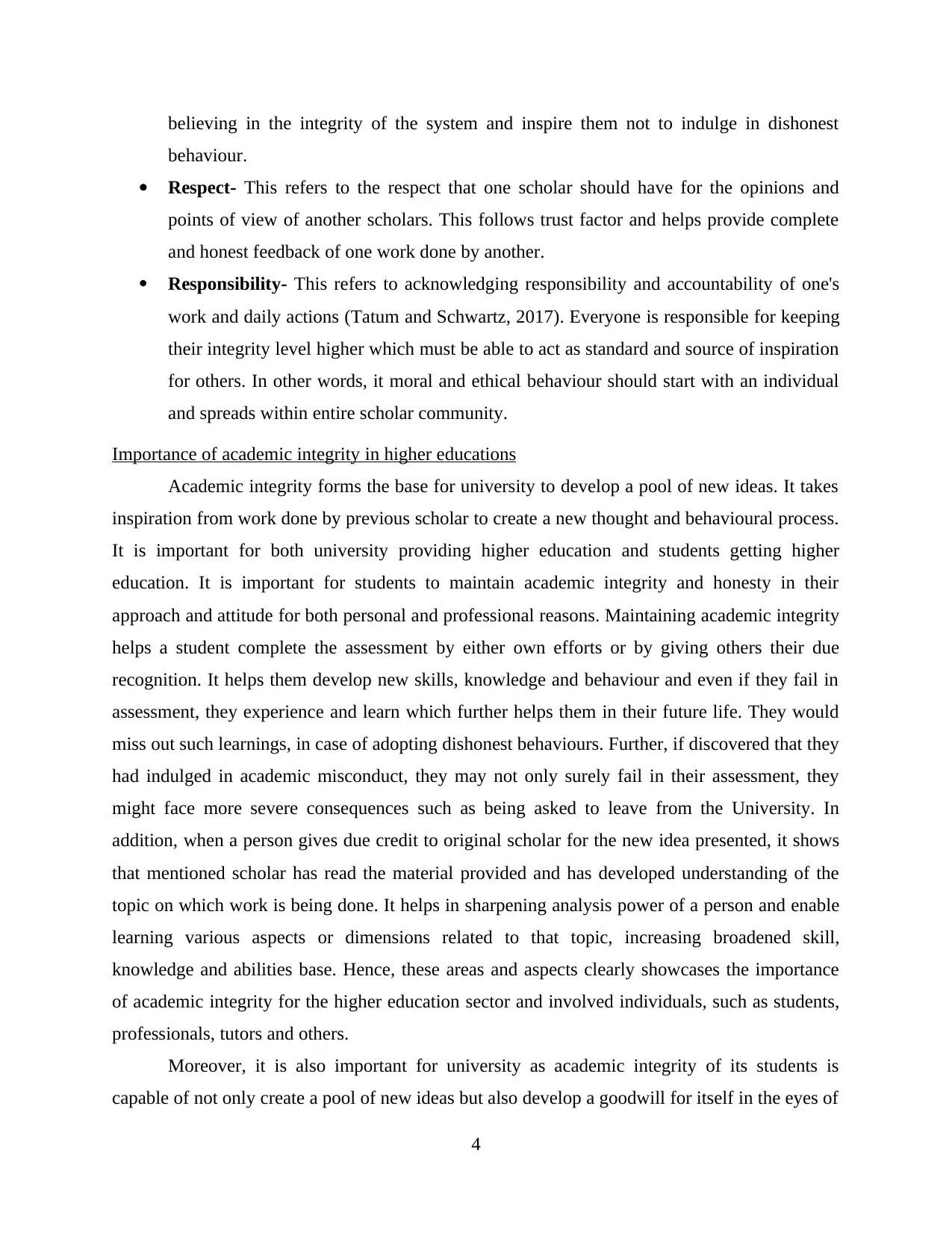
believing in the integrity of the system and inspire them not to indulge in dishonest
behaviour.
Respect- This refers to the respect that one scholar should have for the opinions and
points of view of another scholars. This follows trust factor and helps provide complete
and honest feedback of one work done by another.
Responsibility- This refers to acknowledging responsibility and accountability of one's
work and daily actions (Tatum and Schwartz, 2017). Everyone is responsible for keeping
their integrity level higher which must be able to act as standard and source of inspiration
for others. In other words, it moral and ethical behaviour should start with an individual
and spreads within entire scholar community.
Importance of academic integrity in higher educations
Academic integrity forms the base for university to develop a pool of new ideas. It takes
inspiration from work done by previous scholar to create a new thought and behavioural process.
It is important for both university providing higher education and students getting higher
education. It is important for students to maintain academic integrity and honesty in their
approach and attitude for both personal and professional reasons. Maintaining academic integrity
helps a student complete the assessment by either own efforts or by giving others their due
recognition. It helps them develop new skills, knowledge and behaviour and even if they fail in
assessment, they experience and learn which further helps them in their future life. They would
miss out such learnings, in case of adopting dishonest behaviours. Further, if discovered that they
had indulged in academic misconduct, they may not only surely fail in their assessment, they
might face more severe consequences such as being asked to leave from the University. In
addition, when a person gives due credit to original scholar for the new idea presented, it shows
that mentioned scholar has read the material provided and has developed understanding of the
topic on which work is being done. It helps in sharpening analysis power of a person and enable
learning various aspects or dimensions related to that topic, increasing broadened skill,
knowledge and abilities base. Hence, these areas and aspects clearly showcases the importance
of academic integrity for the higher education sector and involved individuals, such as students,
professionals, tutors and others.
Moreover, it is also important for university as academic integrity of its students is
capable of not only create a pool of new ideas but also develop a goodwill for itself in the eyes of
4
behaviour.
Respect- This refers to the respect that one scholar should have for the opinions and
points of view of another scholars. This follows trust factor and helps provide complete
and honest feedback of one work done by another.
Responsibility- This refers to acknowledging responsibility and accountability of one's
work and daily actions (Tatum and Schwartz, 2017). Everyone is responsible for keeping
their integrity level higher which must be able to act as standard and source of inspiration
for others. In other words, it moral and ethical behaviour should start with an individual
and spreads within entire scholar community.
Importance of academic integrity in higher educations
Academic integrity forms the base for university to develop a pool of new ideas. It takes
inspiration from work done by previous scholar to create a new thought and behavioural process.
It is important for both university providing higher education and students getting higher
education. It is important for students to maintain academic integrity and honesty in their
approach and attitude for both personal and professional reasons. Maintaining academic integrity
helps a student complete the assessment by either own efforts or by giving others their due
recognition. It helps them develop new skills, knowledge and behaviour and even if they fail in
assessment, they experience and learn which further helps them in their future life. They would
miss out such learnings, in case of adopting dishonest behaviours. Further, if discovered that they
had indulged in academic misconduct, they may not only surely fail in their assessment, they
might face more severe consequences such as being asked to leave from the University. In
addition, when a person gives due credit to original scholar for the new idea presented, it shows
that mentioned scholar has read the material provided and has developed understanding of the
topic on which work is being done. It helps in sharpening analysis power of a person and enable
learning various aspects or dimensions related to that topic, increasing broadened skill,
knowledge and abilities base. Hence, these areas and aspects clearly showcases the importance
of academic integrity for the higher education sector and involved individuals, such as students,
professionals, tutors and others.
Moreover, it is also important for university as academic integrity of its students is
capable of not only create a pool of new ideas but also develop a goodwill for itself in the eyes of
4
Paraphrase This Document
Need a fresh take? Get an instant paraphrase of this document with our AI Paraphraser
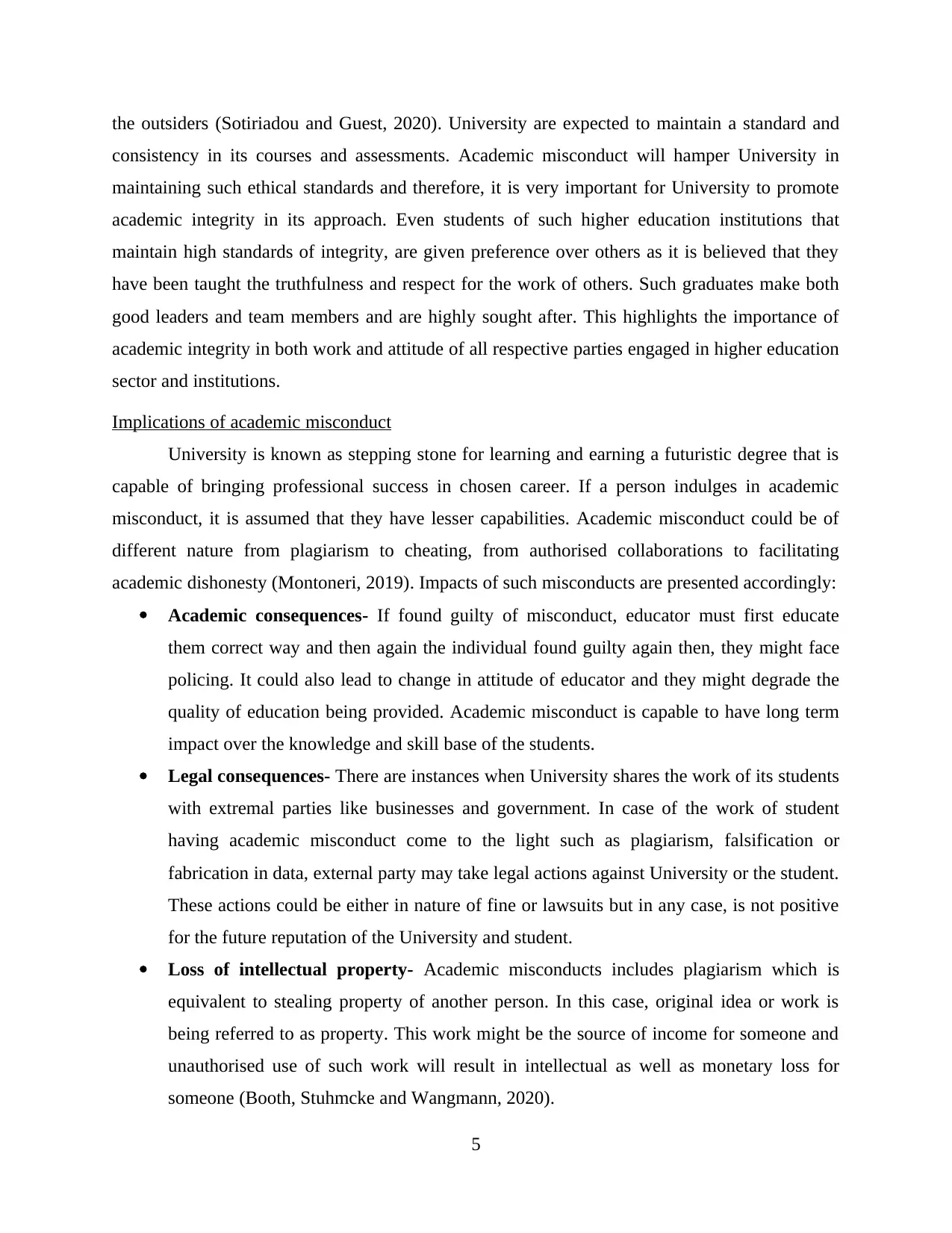
the outsiders (Sotiriadou and Guest, 2020). University are expected to maintain a standard and
consistency in its courses and assessments. Academic misconduct will hamper University in
maintaining such ethical standards and therefore, it is very important for University to promote
academic integrity in its approach. Even students of such higher education institutions that
maintain high standards of integrity, are given preference over others as it is believed that they
have been taught the truthfulness and respect for the work of others. Such graduates make both
good leaders and team members and are highly sought after. This highlights the importance of
academic integrity in both work and attitude of all respective parties engaged in higher education
sector and institutions.
Implications of academic misconduct
University is known as stepping stone for learning and earning a futuristic degree that is
capable of bringing professional success in chosen career. If a person indulges in academic
misconduct, it is assumed that they have lesser capabilities. Academic misconduct could be of
different nature from plagiarism to cheating, from authorised collaborations to facilitating
academic dishonesty (Montoneri, 2019). Impacts of such misconducts are presented accordingly:
Academic consequences- If found guilty of misconduct, educator must first educate
them correct way and then again the individual found guilty again then, they might face
policing. It could also lead to change in attitude of educator and they might degrade the
quality of education being provided. Academic misconduct is capable to have long term
impact over the knowledge and skill base of the students.
Legal consequences- There are instances when University shares the work of its students
with extremal parties like businesses and government. In case of the work of student
having academic misconduct come to the light such as plagiarism, falsification or
fabrication in data, external party may take legal actions against University or the student.
These actions could be either in nature of fine or lawsuits but in any case, is not positive
for the future reputation of the University and student.
Loss of intellectual property- Academic misconducts includes plagiarism which is
equivalent to stealing property of another person. In this case, original idea or work is
being referred to as property. This work might be the source of income for someone and
unauthorised use of such work will result in intellectual as well as monetary loss for
someone (Booth, Stuhmcke and Wangmann, 2020).
5
consistency in its courses and assessments. Academic misconduct will hamper University in
maintaining such ethical standards and therefore, it is very important for University to promote
academic integrity in its approach. Even students of such higher education institutions that
maintain high standards of integrity, are given preference over others as it is believed that they
have been taught the truthfulness and respect for the work of others. Such graduates make both
good leaders and team members and are highly sought after. This highlights the importance of
academic integrity in both work and attitude of all respective parties engaged in higher education
sector and institutions.
Implications of academic misconduct
University is known as stepping stone for learning and earning a futuristic degree that is
capable of bringing professional success in chosen career. If a person indulges in academic
misconduct, it is assumed that they have lesser capabilities. Academic misconduct could be of
different nature from plagiarism to cheating, from authorised collaborations to facilitating
academic dishonesty (Montoneri, 2019). Impacts of such misconducts are presented accordingly:
Academic consequences- If found guilty of misconduct, educator must first educate
them correct way and then again the individual found guilty again then, they might face
policing. It could also lead to change in attitude of educator and they might degrade the
quality of education being provided. Academic misconduct is capable to have long term
impact over the knowledge and skill base of the students.
Legal consequences- There are instances when University shares the work of its students
with extremal parties like businesses and government. In case of the work of student
having academic misconduct come to the light such as plagiarism, falsification or
fabrication in data, external party may take legal actions against University or the student.
These actions could be either in nature of fine or lawsuits but in any case, is not positive
for the future reputation of the University and student.
Loss of intellectual property- Academic misconducts includes plagiarism which is
equivalent to stealing property of another person. In this case, original idea or work is
being referred to as property. This work might be the source of income for someone and
unauthorised use of such work will result in intellectual as well as monetary loss for
someone (Booth, Stuhmcke and Wangmann, 2020).
5
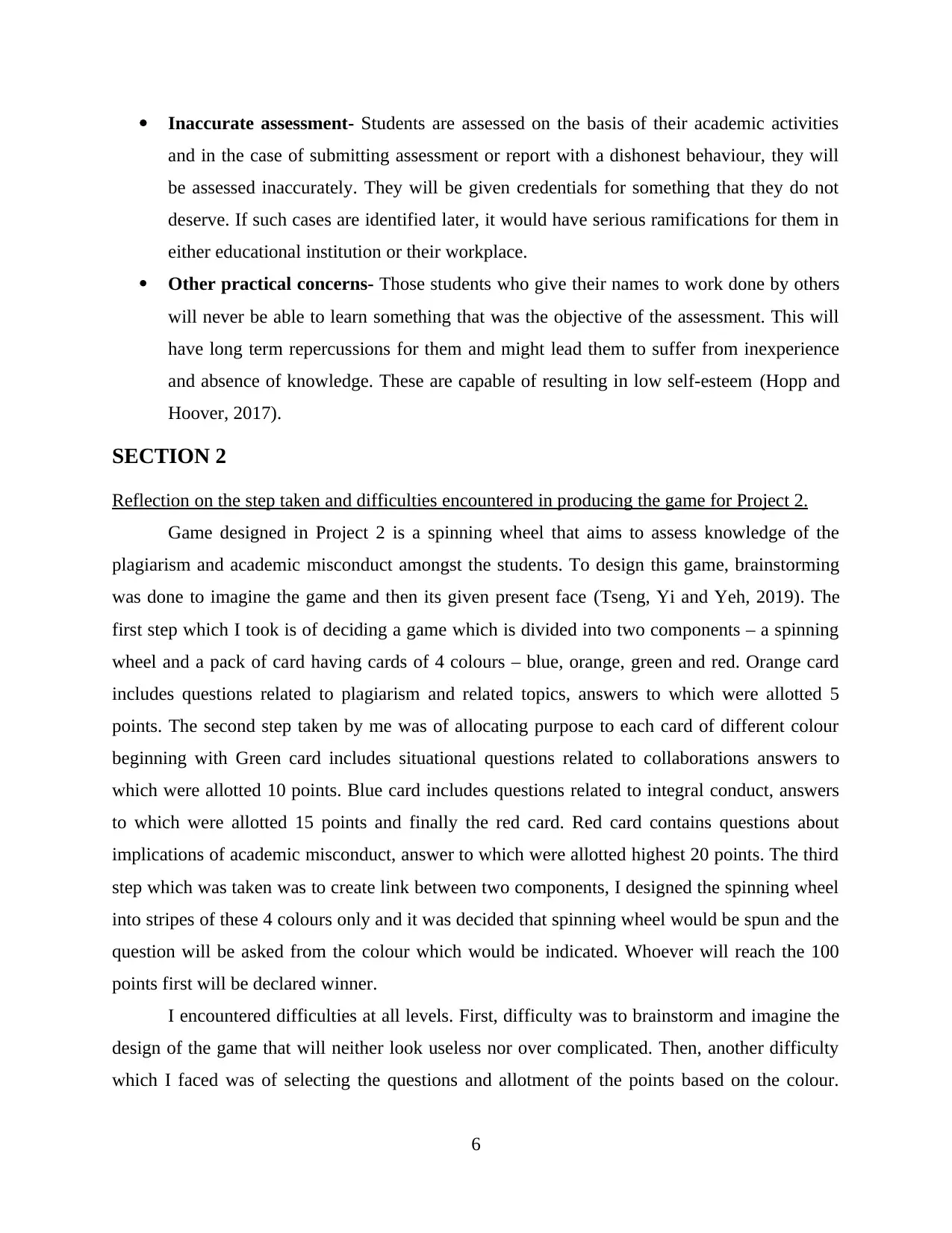
Inaccurate assessment- Students are assessed on the basis of their academic activities
and in the case of submitting assessment or report with a dishonest behaviour, they will
be assessed inaccurately. They will be given credentials for something that they do not
deserve. If such cases are identified later, it would have serious ramifications for them in
either educational institution or their workplace.
Other practical concerns- Those students who give their names to work done by others
will never be able to learn something that was the objective of the assessment. This will
have long term repercussions for them and might lead them to suffer from inexperience
and absence of knowledge. These are capable of resulting in low self-esteem (Hopp and
Hoover, 2017).
SECTION 2
Reflection on the step taken and difficulties encountered in producing the game for Project 2.
Game designed in Project 2 is a spinning wheel that aims to assess knowledge of the
plagiarism and academic misconduct amongst the students. To design this game, brainstorming
was done to imagine the game and then its given present face (Tseng, Yi and Yeh, 2019). The
first step which I took is of deciding a game which is divided into two components – a spinning
wheel and a pack of card having cards of 4 colours – blue, orange, green and red. Orange card
includes questions related to plagiarism and related topics, answers to which were allotted 5
points. The second step taken by me was of allocating purpose to each card of different colour
beginning with Green card includes situational questions related to collaborations answers to
which were allotted 10 points. Blue card includes questions related to integral conduct, answers
to which were allotted 15 points and finally the red card. Red card contains questions about
implications of academic misconduct, answer to which were allotted highest 20 points. The third
step which was taken was to create link between two components, I designed the spinning wheel
into stripes of these 4 colours only and it was decided that spinning wheel would be spun and the
question will be asked from the colour which would be indicated. Whoever will reach the 100
points first will be declared winner.
I encountered difficulties at all levels. First, difficulty was to brainstorm and imagine the
design of the game that will neither look useless nor over complicated. Then, another difficulty
which I faced was of selecting the questions and allotment of the points based on the colour.
6
and in the case of submitting assessment or report with a dishonest behaviour, they will
be assessed inaccurately. They will be given credentials for something that they do not
deserve. If such cases are identified later, it would have serious ramifications for them in
either educational institution or their workplace.
Other practical concerns- Those students who give their names to work done by others
will never be able to learn something that was the objective of the assessment. This will
have long term repercussions for them and might lead them to suffer from inexperience
and absence of knowledge. These are capable of resulting in low self-esteem (Hopp and
Hoover, 2017).
SECTION 2
Reflection on the step taken and difficulties encountered in producing the game for Project 2.
Game designed in Project 2 is a spinning wheel that aims to assess knowledge of the
plagiarism and academic misconduct amongst the students. To design this game, brainstorming
was done to imagine the game and then its given present face (Tseng, Yi and Yeh, 2019). The
first step which I took is of deciding a game which is divided into two components – a spinning
wheel and a pack of card having cards of 4 colours – blue, orange, green and red. Orange card
includes questions related to plagiarism and related topics, answers to which were allotted 5
points. The second step taken by me was of allocating purpose to each card of different colour
beginning with Green card includes situational questions related to collaborations answers to
which were allotted 10 points. Blue card includes questions related to integral conduct, answers
to which were allotted 15 points and finally the red card. Red card contains questions about
implications of academic misconduct, answer to which were allotted highest 20 points. The third
step which was taken was to create link between two components, I designed the spinning wheel
into stripes of these 4 colours only and it was decided that spinning wheel would be spun and the
question will be asked from the colour which would be indicated. Whoever will reach the 100
points first will be declared winner.
I encountered difficulties at all levels. First, difficulty was to brainstorm and imagine the
design of the game that will neither look useless nor over complicated. Then, another difficulty
which I faced was of selecting the questions and allotment of the points based on the colour.
6
⊘ This is a preview!⊘
Do you want full access?
Subscribe today to unlock all pages.

Trusted by 1+ million students worldwide
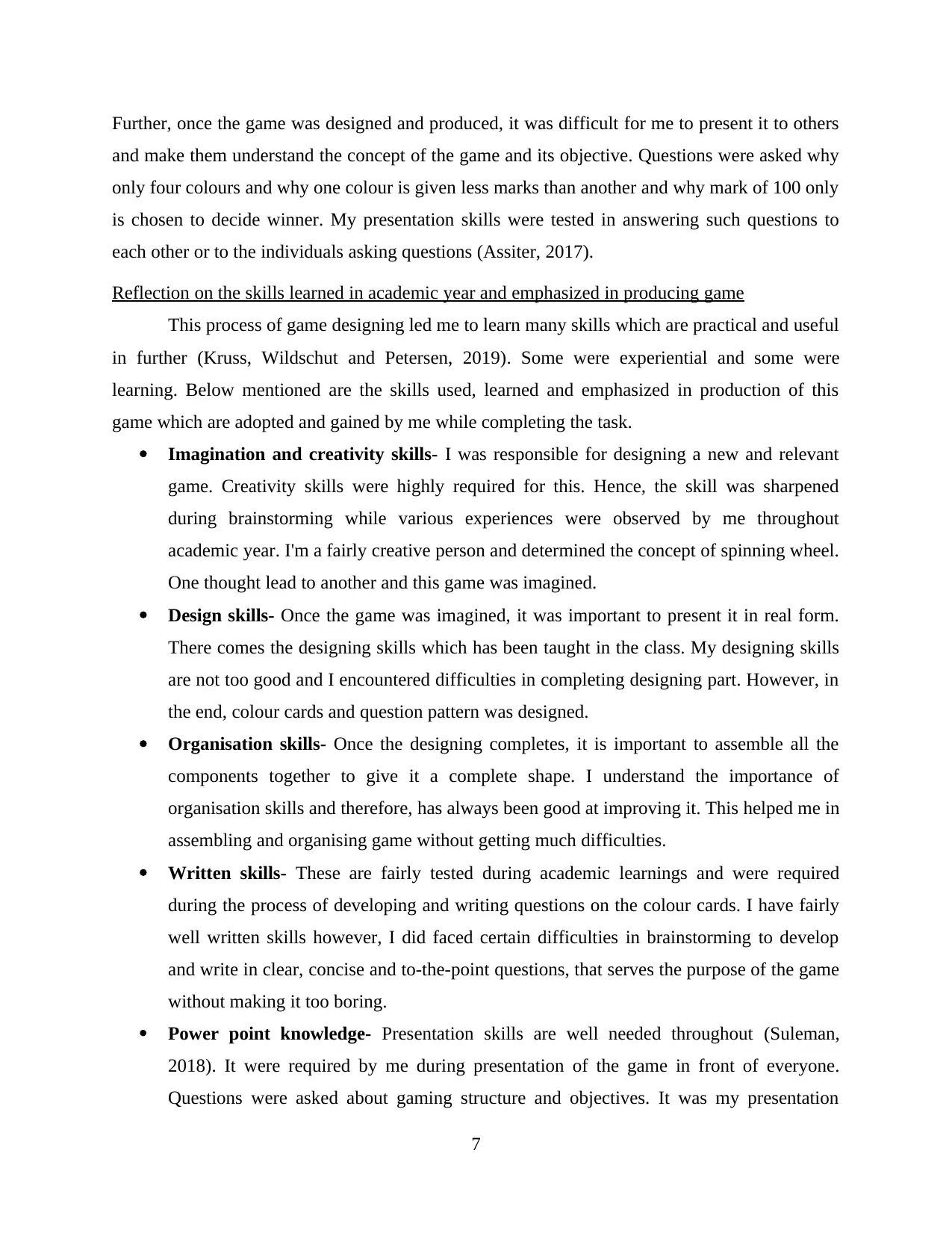
Further, once the game was designed and produced, it was difficult for me to present it to others
and make them understand the concept of the game and its objective. Questions were asked why
only four colours and why one colour is given less marks than another and why mark of 100 only
is chosen to decide winner. My presentation skills were tested in answering such questions to
each other or to the individuals asking questions (Assiter, 2017).
Reflection on the skills learned in academic year and emphasized in producing game
This process of game designing led me to learn many skills which are practical and useful
in further (Kruss, Wildschut and Petersen, 2019). Some were experiential and some were
learning. Below mentioned are the skills used, learned and emphasized in production of this
game which are adopted and gained by me while completing the task.
Imagination and creativity skills- I was responsible for designing a new and relevant
game. Creativity skills were highly required for this. Hence, the skill was sharpened
during brainstorming while various experiences were observed by me throughout
academic year. I'm a fairly creative person and determined the concept of spinning wheel.
One thought lead to another and this game was imagined.
Design skills- Once the game was imagined, it was important to present it in real form.
There comes the designing skills which has been taught in the class. My designing skills
are not too good and I encountered difficulties in completing designing part. However, in
the end, colour cards and question pattern was designed.
Organisation skills- Once the designing completes, it is important to assemble all the
components together to give it a complete shape. I understand the importance of
organisation skills and therefore, has always been good at improving it. This helped me in
assembling and organising game without getting much difficulties.
Written skills- These are fairly tested during academic learnings and were required
during the process of developing and writing questions on the colour cards. I have fairly
well written skills however, I did faced certain difficulties in brainstorming to develop
and write in clear, concise and to-the-point questions, that serves the purpose of the game
without making it too boring.
Power point knowledge- Presentation skills are well needed throughout (Suleman,
2018). It were required by me during presentation of the game in front of everyone.
Questions were asked about gaming structure and objectives. It was my presentation
7
and make them understand the concept of the game and its objective. Questions were asked why
only four colours and why one colour is given less marks than another and why mark of 100 only
is chosen to decide winner. My presentation skills were tested in answering such questions to
each other or to the individuals asking questions (Assiter, 2017).
Reflection on the skills learned in academic year and emphasized in producing game
This process of game designing led me to learn many skills which are practical and useful
in further (Kruss, Wildschut and Petersen, 2019). Some were experiential and some were
learning. Below mentioned are the skills used, learned and emphasized in production of this
game which are adopted and gained by me while completing the task.
Imagination and creativity skills- I was responsible for designing a new and relevant
game. Creativity skills were highly required for this. Hence, the skill was sharpened
during brainstorming while various experiences were observed by me throughout
academic year. I'm a fairly creative person and determined the concept of spinning wheel.
One thought lead to another and this game was imagined.
Design skills- Once the game was imagined, it was important to present it in real form.
There comes the designing skills which has been taught in the class. My designing skills
are not too good and I encountered difficulties in completing designing part. However, in
the end, colour cards and question pattern was designed.
Organisation skills- Once the designing completes, it is important to assemble all the
components together to give it a complete shape. I understand the importance of
organisation skills and therefore, has always been good at improving it. This helped me in
assembling and organising game without getting much difficulties.
Written skills- These are fairly tested during academic learnings and were required
during the process of developing and writing questions on the colour cards. I have fairly
well written skills however, I did faced certain difficulties in brainstorming to develop
and write in clear, concise and to-the-point questions, that serves the purpose of the game
without making it too boring.
Power point knowledge- Presentation skills are well needed throughout (Suleman,
2018). It were required by me during presentation of the game in front of everyone.
Questions were asked about gaming structure and objectives. It was my presentation
7
Paraphrase This Document
Need a fresh take? Get an instant paraphrase of this document with our AI Paraphraser
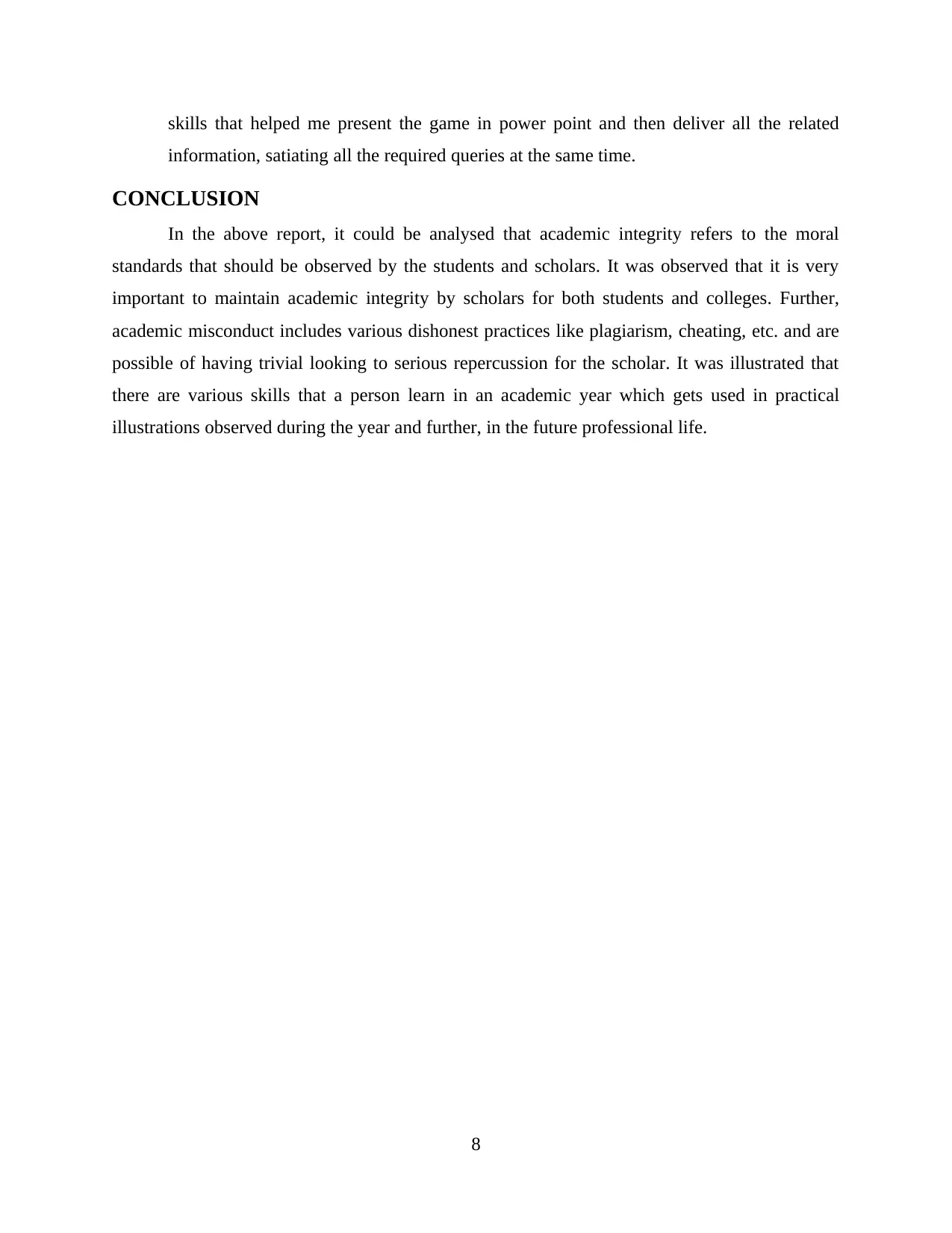
skills that helped me present the game in power point and then deliver all the related
information, satiating all the required queries at the same time.
CONCLUSION
In the above report, it could be analysed that academic integrity refers to the moral
standards that should be observed by the students and scholars. It was observed that it is very
important to maintain academic integrity by scholars for both students and colleges. Further,
academic misconduct includes various dishonest practices like plagiarism, cheating, etc. and are
possible of having trivial looking to serious repercussion for the scholar. It was illustrated that
there are various skills that a person learn in an academic year which gets used in practical
illustrations observed during the year and further, in the future professional life.
8
information, satiating all the required queries at the same time.
CONCLUSION
In the above report, it could be analysed that academic integrity refers to the moral
standards that should be observed by the students and scholars. It was observed that it is very
important to maintain academic integrity by scholars for both students and colleges. Further,
academic misconduct includes various dishonest practices like plagiarism, cheating, etc. and are
possible of having trivial looking to serious repercussion for the scholar. It was illustrated that
there are various skills that a person learn in an academic year which gets used in practical
illustrations observed during the year and further, in the future professional life.
8
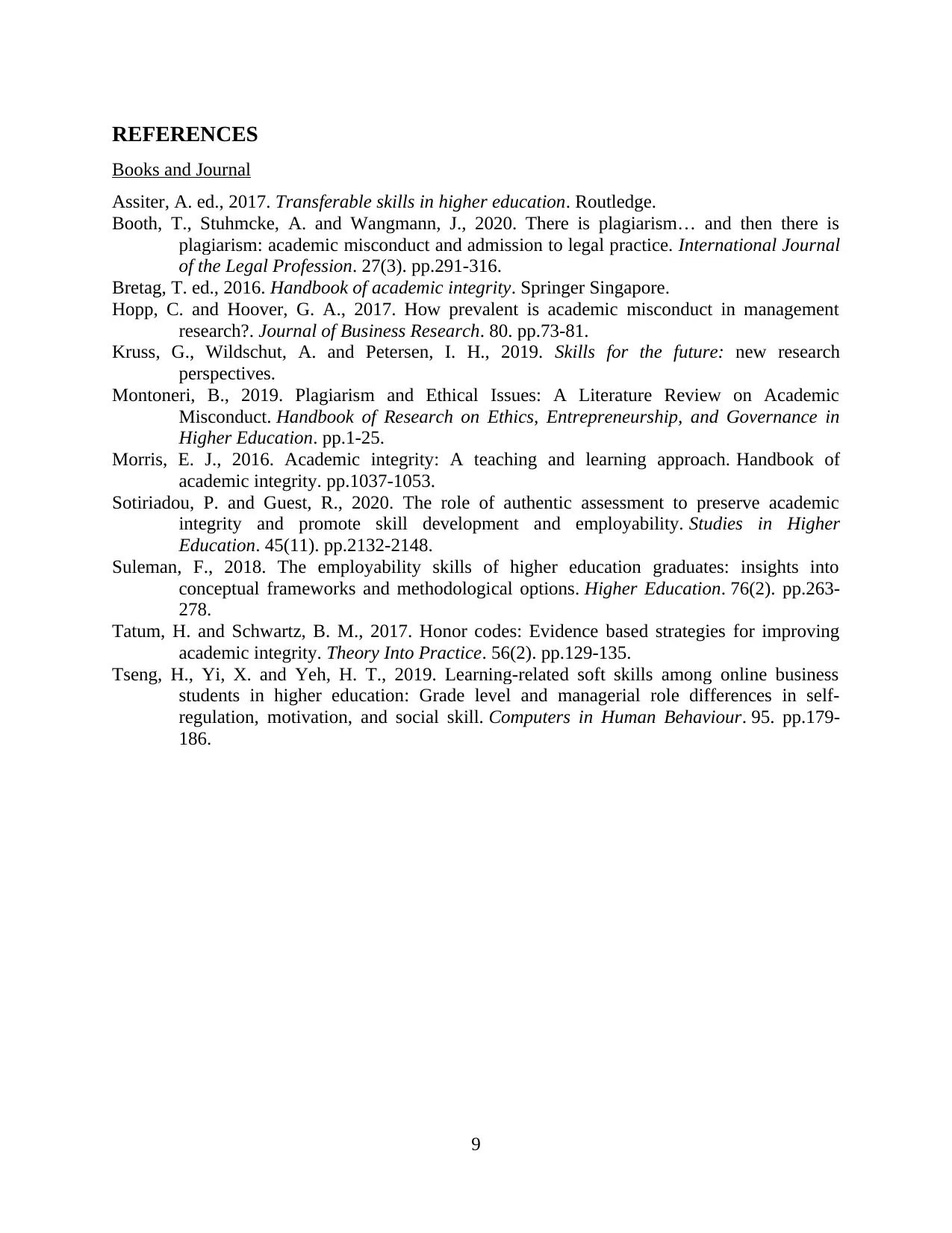
REFERENCES
Books and Journal
Assiter, A. ed., 2017. Transferable skills in higher education. Routledge.
Booth, T., Stuhmcke, A. and Wangmann, J., 2020. There is plagiarism… and then there is
plagiarism: academic misconduct and admission to legal practice. International Journal
of the Legal Profession. 27(3). pp.291-316.
Bretag, T. ed., 2016. Handbook of academic integrity. Springer Singapore.
Hopp, C. and Hoover, G. A., 2017. How prevalent is academic misconduct in management
research?. Journal of Business Research. 80. pp.73-81.
Kruss, G., Wildschut, A. and Petersen, I. H., 2019. Skills for the future: new research
perspectives.
Montoneri, B., 2019. Plagiarism and Ethical Issues: A Literature Review on Academic
Misconduct. Handbook of Research on Ethics, Entrepreneurship, and Governance in
Higher Education. pp.1-25.
Morris, E. J., 2016. Academic integrity: A teaching and learning approach. Handbook of
academic integrity. pp.1037-1053.
Sotiriadou, P. and Guest, R., 2020. The role of authentic assessment to preserve academic
integrity and promote skill development and employability. Studies in Higher
Education. 45(11). pp.2132-2148.
Suleman, F., 2018. The employability skills of higher education graduates: insights into
conceptual frameworks and methodological options. Higher Education. 76(2). pp.263-
278.
Tatum, H. and Schwartz, B. M., 2017. Honor codes: Evidence based strategies for improving
academic integrity. Theory Into Practice. 56(2). pp.129-135.
Tseng, H., Yi, X. and Yeh, H. T., 2019. Learning-related soft skills among online business
students in higher education: Grade level and managerial role differences in self-
regulation, motivation, and social skill. Computers in Human Behaviour. 95. pp.179-
186.
9
Books and Journal
Assiter, A. ed., 2017. Transferable skills in higher education. Routledge.
Booth, T., Stuhmcke, A. and Wangmann, J., 2020. There is plagiarism… and then there is
plagiarism: academic misconduct and admission to legal practice. International Journal
of the Legal Profession. 27(3). pp.291-316.
Bretag, T. ed., 2016. Handbook of academic integrity. Springer Singapore.
Hopp, C. and Hoover, G. A., 2017. How prevalent is academic misconduct in management
research?. Journal of Business Research. 80. pp.73-81.
Kruss, G., Wildschut, A. and Petersen, I. H., 2019. Skills for the future: new research
perspectives.
Montoneri, B., 2019. Plagiarism and Ethical Issues: A Literature Review on Academic
Misconduct. Handbook of Research on Ethics, Entrepreneurship, and Governance in
Higher Education. pp.1-25.
Morris, E. J., 2016. Academic integrity: A teaching and learning approach. Handbook of
academic integrity. pp.1037-1053.
Sotiriadou, P. and Guest, R., 2020. The role of authentic assessment to preserve academic
integrity and promote skill development and employability. Studies in Higher
Education. 45(11). pp.2132-2148.
Suleman, F., 2018. The employability skills of higher education graduates: insights into
conceptual frameworks and methodological options. Higher Education. 76(2). pp.263-
278.
Tatum, H. and Schwartz, B. M., 2017. Honor codes: Evidence based strategies for improving
academic integrity. Theory Into Practice. 56(2). pp.129-135.
Tseng, H., Yi, X. and Yeh, H. T., 2019. Learning-related soft skills among online business
students in higher education: Grade level and managerial role differences in self-
regulation, motivation, and social skill. Computers in Human Behaviour. 95. pp.179-
186.
9
⊘ This is a preview!⊘
Do you want full access?
Subscribe today to unlock all pages.

Trusted by 1+ million students worldwide
1 out of 9
Related Documents
Your All-in-One AI-Powered Toolkit for Academic Success.
+13062052269
info@desklib.com
Available 24*7 on WhatsApp / Email
![[object Object]](/_next/static/media/star-bottom.7253800d.svg)
Unlock your academic potential
Copyright © 2020–2025 A2Z Services. All Rights Reserved. Developed and managed by ZUCOL.




